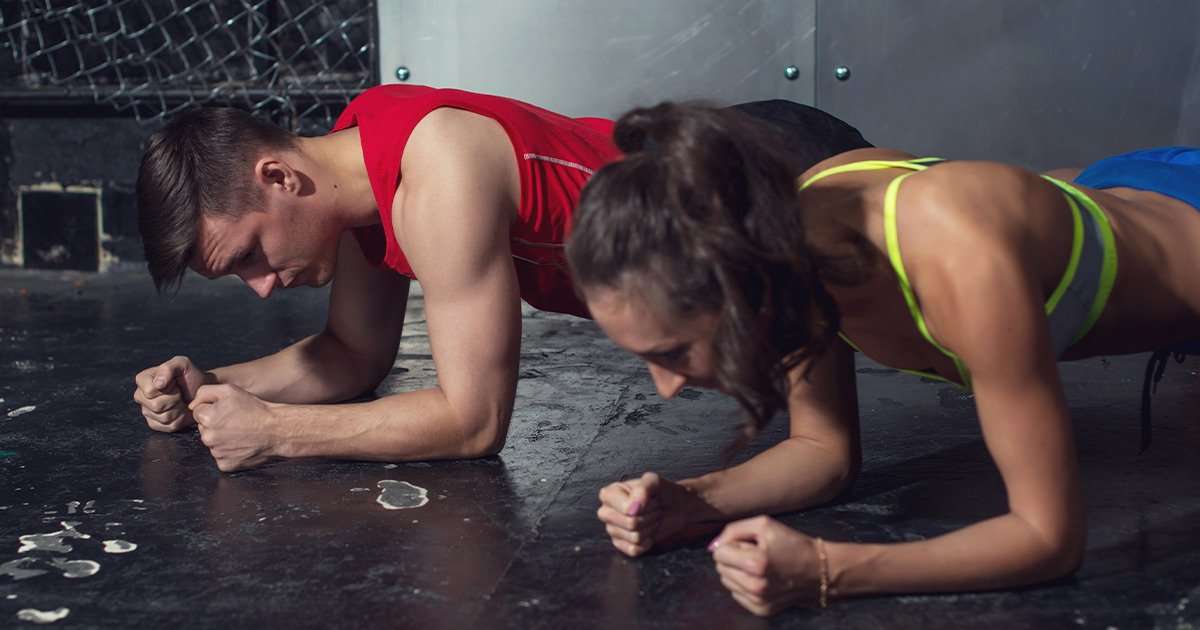Whether you’re a beginner or a seasoned fitness enthusiast, understanding these 12 gym terms is essential for achieving your fitness goals. In this comprehensive guide, we break down each term and explain its significance in your workout routine.
Being a beginner in an unfamiliar setting can be intimidating at first. It can also be confusing.
If you hear people in a gym throwing around words you don’t know, and you don’t feel comfortable asking what they mean, it could be even more frustrating.
Fortunately, M&S has you covered. A while back we released a gym glossary with some definitions that can help you learn the training language.
Here, we provide even more terms and phrases that can help you lifting rookies know what we’re talking about.
The 12 Gym Terms Everybody Needs to Know
1. Concentric
This is the actual lifting of the weight and contraction of the muscle you’re training. The obvious example is a barbell curl.
When you use the force in your biceps to curl the barbell up, this is the concentric portion of the rep. A lifter can either perform the concentric portion as quickly as possible to maximize power and speed, or it can be performed under control to maximize the tension on the working muscles.
It’s also known as the “positive” portion of the rep.
Related: Essential Muscle Building Supplements in 2023
2. Contraction
The contraction is the flexing of the muscle.
It can be performed at the top of a rep when the weight is lifted, or it can be when a muscle is randomly flexed on its own.
Need an example? Flex your bicep, right now. Feel that? You just contracted the muscle.

3. Drop Set
Drop sets are a popular and effective way to train the muscles beyond one point of failure.
The lifter would reduce the weight being used after reaching failure, then perform more reps until failure is reached for a second time.
Let’s use the leg press as an example here. If you’re pressing 500 pounds, and you reach failure after 10 reps, you could reduce the weight by 100 pounds or so, then get back into position and perform more reps.
The weight that is reduced is up to the lifter or trainer. There’s no standard number or percentage. If the weight is dropped twice in one set, it’s known as a “double drop set.”
Related: How to Use Drop Sets For Strength & Hypertrophy
4. Eccentric
We covered the concentric portion of a rep earlier. Eccentrics are when the tension on the muscle is reduced and the weight is lowered back to the starting position.
These should always be performed under control for two reasons.
First, performing eccentrics too quickly can cause potential injuries. Second, the eccentric phase is actually when the muscle is at its strongest, so you can train them more effectively by taking time to go from a contracted position to its starting point.
The longer you perform the eccentric, the more challenging it becomes. Some programs call for five to ten-second eccentrics, also known as “negatives.”
Related: Beginner Nutrition Mistakes to Avoid in 2023: A Comprehensive Guide
5. Progressive Overload
This is a principle that you may have already followed without knowing it. The most common form of progressive overload is when you increase the weight that you’re using over the course of the number of sets you’re performing.
If you were to perform the bench press for three sets of 10 reps, then you would add weight to each set, even though the reps remain the same. This means the first two sets wouldn’t be performed to failure.
The first set of 135 pounds may be easy, followed by a more challenging set with 155 pounds. Neither set provided a maximum challenge. Then, you add 30 more pounds to the bar to make it 185, and 10 reps are all you get. You’ve now reached failure by progressive overload.
Progressive overload can also be applied to reps and minutes performed on cardio.
6. RIR
This stands for “Reps in Reserve.”
If you see a training log or program with this, then it likely means that you shouldn’t perform that set to failure.
For example, if you’re performing seated dumbbell curls, and your log reads “10 reps, 2 RIR,” then you should perform the set until you can do 2 more reps, but you stop at that point.
So, you want to choose a weight that you can do for 12 reps. If that would be 30 pounds, then you would grab the 30’s and stop at 10 reps.
Related: The Clean Bulk Diet: 3 Options For Lean Muscle
7. RPE
This acronym means “Rating of Perceived Exertion” or “Rate of Perceived Effort.” It’s more commonly used in powerlifting and strongman circles than in bodybuilding training.
Instead of focusing on the weight, you pay attention to the effort you’re giving based on a scale of 1-10.
If you were to perform squats for 4 reps with an RPE of 8, then you load weight that would require 80% of your effort to lift for 4 reps. If the RPE is 10, then obviously you would go to complete failure. RPE of 5 is pretty much warming up.
8. Rest-Pause Set
This is another training method that allows someone to reach failure more than once, but the weight doesn’t have to be reduced.
The lifter would perform reps until failure is reached. After a 10-15 second rest, the lifter performs more reps with the same weight until failure is reached a second time.
If you were to perform seated rows with 150 pounds for 10 reps, then you would stop after the 10th rep, count to 10 or 15, then continue. You shouldn’t get more than five reps or so after that short rest. If you can, then either you didn’t really train to failure, or you should use a heavier weight.

9. Shredded
If someone says you’re shredded, then it means you’re very lean, which is a compliment.
You have visible striations and the muscles can be seen very clearly. Bodybuilders and fitness people love hearing this.
Other synonyms include “ripped,” sliced,” “diced,” and “cut,” While the compliment is usually welcomed with open ears, be warned. If you don’t have abs, you ain’t shredded.
10. Static Hold
Static holds are also known as isometric holds. They are used to help prepare the body for work to come, or they can be another way to train a muscle beyond failure.
If you’ve performed planks or squats in the bottom position for extended periods of time, then you’ve performed static holds. This is a great way to warm-up at the beginning of a session.
Another static hold can be performed at the end of a set.
Let’s use the incline dumbbell press as the example. You’ve reached the last rep you can perform. If you try again, then the weight won’t go up. Instead, hold the weight at the top and squeeze the chest as hard as you can for as long as you can.
Bodybuilders use this method because they believe it will add density and thickness to the muscles being worked.
Related: 5 Full Body Workouts Without Steroids for Serious Gains
11. Triset
You may be familiar with a superset, which is two exercises performed back-to-back without rest in between.
A trust sees that and raises you one. Performing three exercises in a row will be an intense challenge.
These are best performed with movements or machines that don’t require much travel or transition time. If you try to work on opposite ends of the gym at the same time, someone may jump in your machine when you’re not using it.
One great way to perform trisects is with dumbbells. A popular shoulder grouping is front raises, lateral raises, and rear lateral raises. You can perform all three with the same pair of weights without moving. These can be done at home or in the gym.
Related: 5 Quick muscle-building Breakfast Ideas
12. Volume
Most people think that volume is strictly based on the number of sets you do.
Volume is a metric that can determine how much effort you’ve put in the workout. The most popular way to determine volume is by weights, sets, and reps.
If you lift 100 pounds for three sets of ten reps, then you would multiply those numbers to determine your volume for that exercise.
100 pounds x 3 sets x 10 reps = 3,000 pounds of volume.
Some lifters have the goal of performing the most volume possible over the course of a workout. If you see the word “volume” applied to a program, then it could be about this, or simply making sure you do a high number of exercises and sets.
More Essential Gym Terms
Cardio
Cardio refers to any form of exercise that increases your heart rate and respiration, such as running, cycling, or swimming. Cardio is essential for maintaining overall health and fitness
HIIT
HIIT, or high-intensity interval training, involves short bursts of high-intensity exercise followed by periods of rest or low-intensity exercise. HIIT is great for burning fat and increasing cardiovascular fitness.
DOMS
DOMS, or delayed onset muscle soreness, refers to the soreness and stiffness you feel in your muscles a day or two after a workout. DOMS is a normal and common response to exercise, especially when trying new movements or increasing intensity. It’s important to listen to your body and allow adequate rest and recovery time to prevent injury.
Form
Form refers to the proper technique and alignment used during exercises. Proper form is essential for preventing injury and ensuring that the intended muscle groups are being targeted. It’s important to learn proper form from a qualified fitness professional and to continually check and correct form during workouts.
What’s Your Favorite Gym Term?
If there is a word you know that didn’t make the list, add it in the comments section below.
Make sure you give the definition so we can all benefit from the knowledge you’re bestowing upon the M&S community.

ydbvpi
vurcazkircazpatliycaz.CBpbOyeiYnR1
vurucuteamgeldi.qk6jJ0RiCC9b
daktilogibigibi.M9K6uuuNfSmA
daxktilogibigibi.apm5XVwGxvlr
xyandanxvurulmus.dkMT9qBkXZMW
xbunedirloooo.zXd36k0sWort
palynology xyandanxvurulmus.7mt8mR22kFNS
schalsteins xyandanxvurulmus.CTzj9utD7WSj
amciik siteleri vurgunyedim.NjyKxJCCieBN
amciik siteleri yaralandinmieycan.jZA5gJzwAI1F
BİZİ SİK BİZ BUNU HAK EDİYORUZ citixx.5trR74bsfBWr
porn siteleri hyuqgzhqt.ssvLasPfnB81
amciik siteleri ewrjghsdfaa.CF8s0HphfJQm
pornhub bahis siteleri wrtgdfgdfgdqq.74qwYRp19SQn
watch porn video wrtgdfgdfgdqq.y7bTxrOo54UL
Your passion for the subject shines through your words.If anyone wants to read the topic in more details then visit 8xbet
Insightful and thought-provoking. Well done!NaN
I learned something new today. Thanks!If anyone wants to read the topic in more details then visit 8xbet
Your post resonated with me on a personal level.If anyone wants to read the topic in more details then visit 8xbet
I’m eager to read more from you. Keep it up!If anyone wants to read the topic in more details then visit 8xbet
I enjoyed reading every word. Thank you for sharing.If anyone wants to read the topic in more details then visit 8xbet
porno siteleri pompadirha.s71Ne2VdckRn
fuck asillartaklitler.qMWIJkjJ1lq1
porn siteleri hephupx.9iOiiOYchYd9
bahis siteleri incest category hepxhupx.6oVeaedkLk3t
seksi siteler juljulfbi.EjjIk6YFD1ws
food porn bjluajszz.PJlqjooozonC
bahis siteleri child porn bxjluajsxzz.Ai8ow2K3t57p
bahis siteleri child porn 0qbxjluaxcxjsxzz.4EECRBHIzoRU
ben bir yeteneksiz orospu cocuguyum
porno izle pokkerx.Lj0P4AN3hWj2
bahis siteleri incest category footballxx.uf9RDyRoIbsw
bahis siteleri child porn mobileidn.Z0Wv0aezpaKK
eskort siteleri bingoxx.YIuliRr2XzKC
sexax 250tldenemebonusuxx.JQwXzkAYljwg
eski rahatiniz olmayacak eyeconartxx.F4LC8FqnDSqq
porn sex vvsetohimalxxvc.l6cEAVHvIVmM
eskort siteleri tthighereduhryyy.vnGrJ66BIXc
child porn
Orion Bar Vapes offers a premium vaping experience with their sleek and portable disposable vape bars. Explore a range of delicious flavors and enjoy smooth satisfaction with Orion Bar Vapes.
best porn videos download ggjinnysflogg.RbdCSxg2dnX
Wow, amazing blog format! How lengthy have you been blogging for?
you make running a blog look easy. The overall look
of your website is excellent, let alone the content!
You can see similar here sklep online
Hello! Do you know if they make any plugins to help with
Search Engine Optimization? I’m trying to get my blog to
rank for some targeted keywords but I’m not seeing very good results.
If you know of any please share. Kudos!
You can read similar art here: Ecommerce
goodhere Fake Taxi porn vurucutewet.R1QcE5D29Ia
Howdy! Do you know if they make any plugins to help with SEO?
I’m trying to get my blog to rank for some targeted keywords but I’m not seeing very good gains.
If you know of any please share. Cheers! You can read similar art here:
Sklep online
Good day! Do you know if they make any plugins to help with SEO?
I’m trying to get my blog to rank for some targeted keywords but I’m not seeing very good
results. If you know of any please share. Many thanks!
You can read similar art here: Dobry sklep
Good day! Do you know if they make any plugins to help with Search Engine Optimization? I’m trying to get my blog to rank for some targeted keywords but I’m
not seeing very good gains. If you know of any please share.
Appreciate it! You can read similar text here: Najlepszy sklep
अन्तरजातीय अश्लील qqyyooppxx.PiZEcRtH8fY
सह शॉट पोर्न के बा hjkvbasdfzxzz.BAgiJJyizC9
मजेदार सेक्स पोर्न txechdyzxca.U2ayrSeAQ7T
तांडव अश्लील hkyonet.vHCINrRcV0G
Hi! Do you know if they make any plugins to assist with SEO?
I’m trying to get my site to rank for some targeted keywords but I’m not seeing very good results.
If you know of any please share. Appreciate it!
I saw similar art here: Scrapebox AA List
Hi there! Do you know if they make any plugins to help
with Search Engine Optimization? I’m trying to get my blog to
rank for some targeted keywords but I’m not seeing very good results.
If you know of any please share. Kudos! You can read similar article here:
Backlinks List
ਵੱਡੀ ਛਾਤੀ ਪੋਰਨ madisonivysex.HmqcpHP8XrZ
Hello there! Do you know if they make any plugins to help
with Search Engine Optimization? I’m trying to get my site to
rank for some targeted keywords but I’m not seeing very good gains.
If you know of any please share. Kudos! You can read similar art here:
GSA Verified List
Howdy! Do you know if they make any plugins to help with Search Engine Optimization? I’m trying to get
my blog to rank for some targeted keywords but I’m not seeing very good results.
If you know of any please share. Cheers! I saw similar article here:
List of Backlinks
ladesbet ਵੱਡੇ ਗਧੇ ਪੋਰਨ ladesinemi.sDpyVizU0el
ladesbet 毛深いポルノ ladestinemi.JAYb1tiPsWM
senin o bacini sikicem
Wow, marvelous weblog format! How lengthy have you been blogging for?
you made running a blog look easy. The full look of your website
is magnificent, as neatly as the content! You can see similar here e-commerce
Wow, amazing blog format! How long have you ever been blogging for?
you make running a blog look easy. The overall look of your web site is great, let alone the content!
You can see similar here ecommerce
azithromycin 600 mg
Wow, superb weblog format! How lengthy have you ever been running a blog for?
you made running a blog look easy. The whole look of your web site is excellent, as well as the content!
You can see similar here dobry sklep
batmanapollo.ru
Discover Bwer Pipes: Your Source for Quality Irrigation Products in Iraq: Bwer Pipes offers a wide selection of irrigation solutions designed to meet the diverse needs of Iraqi agriculture. Whether you need pipes, sprinklers, or accessories, we have everything you need to enhance your farm’s productivity. Learn More
cialis 10 mg online
консультация профессионального психолога w-495.ru
Deneme bonusu veren siteler
2024 bahis siteleri güncel listesi üzerinden deneme bonusu
kampanyasına ulaşın.